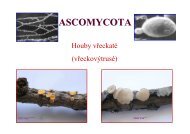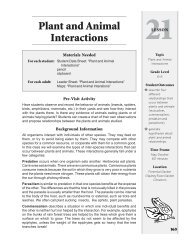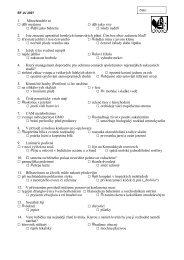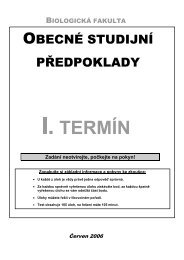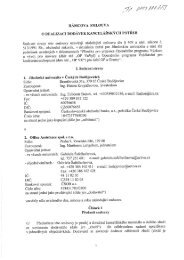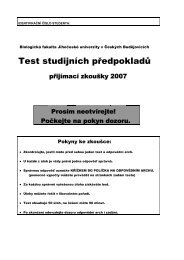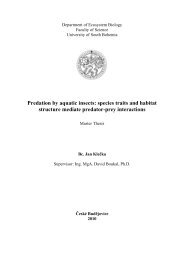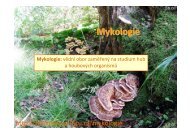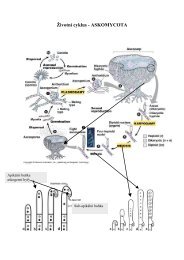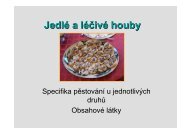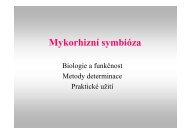The structure and dynamics of a water beetle community in a ...
The structure and dynamics of a water beetle community in a ...
The structure and dynamics of a water beetle community in a ...
Create successful ePaper yourself
Turn your PDF publications into a flip-book with our unique Google optimized e-Paper software.
calculated from the total number <strong>of</strong> species with aquatic adults (note, however, that sampl<strong>in</strong>g<br />
effort was very different among methods). In larvae, 29% <strong>of</strong> species was common to all<br />
methods, 14% <strong>of</strong> species was collected exclusively by activity traps (especially large<br />
Dytiscidae), 3% by box trap, 29% by h<strong>and</strong>net sampl<strong>in</strong>g, <strong>and</strong> 31% <strong>of</strong> species was unique for<br />
box trap <strong>and</strong> h<strong>and</strong>net sampl<strong>in</strong>g taken together. <strong>The</strong> highest number <strong>of</strong> species <strong>of</strong> adults was<br />
sampled by activity traps; <strong>in</strong> larvae, h<strong>and</strong>net sampl<strong>in</strong>g collected the highest number <strong>of</strong><br />
species, followed by activity traps (Appendix 1).<br />
Rarefaction analyses revealed that the sample sizes obta<strong>in</strong>ed by each method were<br />
sufficient to ga<strong>in</strong> good estimates <strong>of</strong> the total number <strong>of</strong> species detectable by the method<br />
(Table 1). In adults as well as <strong>in</strong> larvae, the rarefaction curves <strong>and</strong> species richness estimators<br />
ICE <strong>and</strong> Chao2 converge (Figs. 2 <strong>and</strong> 3; other popular estimators ACE <strong>and</strong> Chao1 performed<br />
very similarly). In rarefaction-based analyses, the light trap had the lowest number <strong>of</strong> species<br />
<strong>of</strong> aquatic adults as well as the lowest adult diversity at the level <strong>of</strong> 400 <strong>in</strong>dividuals. Other<br />
methods yield considerably higher numbers <strong>of</strong> species <strong>and</strong> diversity values <strong>and</strong> perform<br />
similarly at this level. In the larvae, the number <strong>of</strong> species was lowest <strong>in</strong> the box trap data <strong>and</strong><br />
highest <strong>in</strong> the h<strong>and</strong>net data. <strong>The</strong> diversity <strong>of</strong> larvae sampled by activity traps was<br />
considerably higher than by box trap <strong>and</strong> h<strong>and</strong>net (Figs. 4 <strong>and</strong> 5).<br />
Fig. 2 – Sample-based rarefaction curves for data from the four collect<strong>in</strong>g methods (mean observed number <strong>of</strong><br />
species <strong>and</strong> 95% confidence <strong>in</strong>terval as th<strong>in</strong> black l<strong>in</strong>es, ICE=thick dashed black l<strong>in</strong>e, Chao2=thick dashed gray<br />
l<strong>in</strong>e).<br />
14



